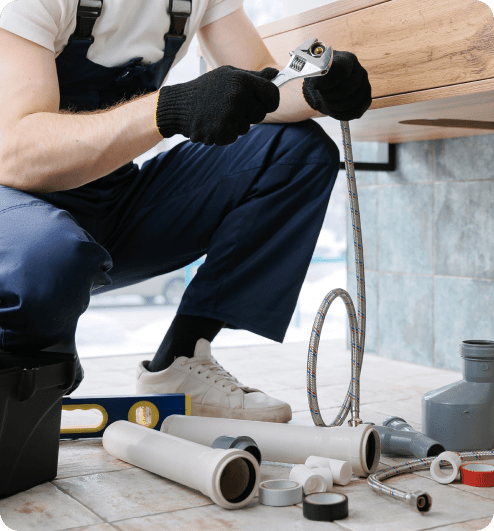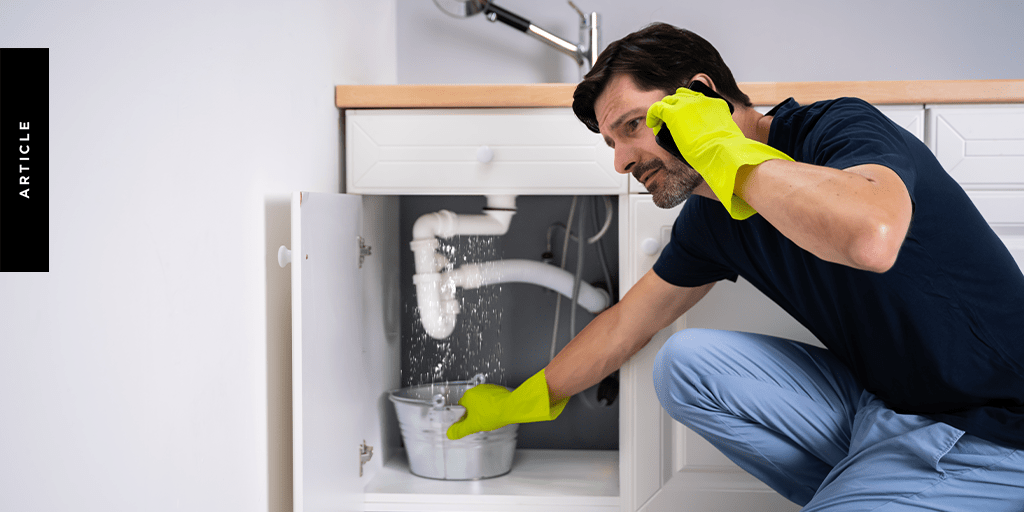Flexi-hoses in homes or commercial properties built in the past 30 years could be a ticking time bomb.
How can you know if your property is at risk?
This article explains what they are, the damage they can cause and preventative measures.
What are flexi-hoses?
Affordable and easy to install, flexible plumbing hoses, also known as flexi-hoses, have become standard in modern construction. They have a malleable inner rubber pipe protected with braided layers of stainless steel. Flexi-hoses are ideal where rigid pipes aren’t suitable due to limited space or the requirement for flexibility.
However, they last just five to 15 years. Alarmingly, they can suddenly fail, leading to severe damage in homes. In fact, insurance claims due to water damage from flexi-hose failures are becoming more frequent and expensive. Homeowners and businesses are feeling the sting.
Typically found in kitchens and bathrooms, flexi-hoses can fail and cause extensive damage, from cabinetry to electrical systems. For instance, a Melbourne resident suffered more than $40,000 worth of damage in just 10 minutes, according to The Australian Financial Review.

How Flexi-hoses Affect Construction & Plumbing Businesses
For plumbers and contractors, the failure of a flexi-hose in your clients’ property can also puncture your business. A burst hose in a home you’ve serviced could harm your reputation if you haven’t forewarned your clients about the risks.
In an industry where word of mouth is key, proactive maintenance and communication can make your business standout among competitors.
So, ensure you educate clients about the importance of checking and replacing flexi-hoses. That will position you as a professional who cares about customers’ long-term safety, trust and loyalty to your business.

Financial & Legal Liabilities
You could leave your business to financial and legal repercussions by not informing your clients about the need for regular maintenance of their flexi-hoses. That means telling them about potential issue and advising them to replace hoses before they fail.
If a client’s insurance claim is denied because of poor maintenance, they might call on your business for compensation, particularly if you didn’t give adequate advice.
Don’t leave it to chance! Have a solid communication strategy in place. It could be as easy as having scheduled email reminders to clients to inspect their flexi-pipes every six months. In that message, you might also want to add that it’s not a good idea to store chemicals near the pipes, as this will cause the pipes to erode. Suggest to property owners that they should switch off the water supply at the mains if they are going away on vacation, too.
Every six months, they should look for any signs of wear or damage that could lead to flexi-hose failure. Problems include rust marks, bulges, fraying or kinking – any sign means they should replace the flexi-hose immediately. Ideally, the flexible braided hose should have a tag with an expiry date – if it’s past or there’s no tag, that’s the time for the property owner to call a licensed plumber. Property owners should made aware of high-risk areas like multi-storey homes or apartments where water damage can spread rapidly.
Additionally, every two years, a licensed plumber should do a thorough evaluation.
Turning Maintenance Into A Business Opportunity
Regular maintenance of flexi-hoses can be an opportunity to grow your business. Consider offering an annual or six-monthly inspection service to check for leaks, bulges, or discolouration. This simple upsell could give your business another income stream that fosters client relationships, too.
Regular checks mean your business isn’t just fixing problems but preventing them.
Preventative Measures to Roll Out
As a plumbing or construction business, you have the expertise to help clients avoid the nightmare of water damage that burst flexi-hoses can cause.
One of the best preventative measures is to advise property owners to replace their hoses every five years. With clients’ regular checks in between that, it can prevent bigger problems down the line.
Communication is also key. Let your clients know about the importance of flexi-hose maintenance, especially if they live in high-risk areas like multi-storey homes or apartments where water damage can spread quickly. Educating them on the risks allows you to offer solutions, such as higher-quality hoses that meet stricter standards.

Review Your Installation Practices
It’s a good time to reassess your processes for installing and maintaining flexi-hoses.
Use hoses that meet higher quality standards to reduce the risk of failure and damage.
Offer maintenance plans to clients to ensure they’re protected in the long term. As a business that takes a proactive approach, you safeguard your clients’ properties and, therefore, buffer your business from the potential financial and legal risks of flexi-hose failures.

